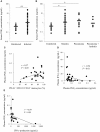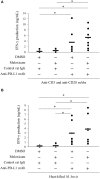Upregulation of PD-L1 Expression by Prostaglandin E2 and the Enhancement of IFN-γ by Anti-PD-L1 Antibody Combined With a COX-2 Inhibitor in Mycoplasma bovis Infection
- PMID: 32154274
- PMCID: PMC7045061
- DOI: 10.3389/fvets.2020.00012
Upregulation of PD-L1 Expression by Prostaglandin E2 and the Enhancement of IFN-γ by Anti-PD-L1 Antibody Combined With a COX-2 Inhibitor in Mycoplasma bovis Infection
Abstract
Bovine mycoplasmosis caused by Mycoplasma bovis results in pneumonia and mastitis in cattle. We previously demonstrated that the programmed death 1 (PD-1)/PD-ligand 1 (PD-L1) pathway is involved in immune dysfunction during M. bovis infection and that prostaglandin E2 (PGE2) suppressed immune responses and upregulated PD-L1 expression in Johne's disease, a bacterial infection in cattle. In this study, we investigated the role of PGE2 in immune dysfunction and the relationship between PGE2 and the PD-1/PD-L1 pathway in M. bovis infection. In vitro stimulation with M. bovis upregulated the expressions of PGE2 and PD-L1 presumably via Toll-like receptor 2 in bovine peripheral blood mononuclear cells (PBMCs). PGE2 levels of peripheral blood in infected cattle were significantly increased compared with those in uninfected cattle. Remarkably, plasma PGE2 levels were positively correlated with the proportions of PD-L1+ monocytes in M. bovis-infected cattle. Additionally, plasma PGE2 production in infected cattle was negatively correlated with M. bovis-specific interferon (IFN)-γ production from PBMCs. These results suggest that PGE2 could be one of the inducers of PD-L1 expression and could be involved in immunosuppression during M. bovis infection. In vitro blockade assays using anti-bovine PD-L1 antibody and a cyclooxygenase 2 inhibitor significantly upregulated the M. bovis-specific IFN-γ response. Our study findings might contribute to the development of novel therapeutic strategies for bovine mycoplasmosis that target PGE2 and the PD-1/PD-L1 pathway.
Keywords: Mycoplasma bovis; PD-1; PD-L1; T-cell exhaustion; cattle; immune dysfunction; immunoinhibitory molecules; prostaglandin E2.
Copyright © 2020 Goto, Konnai, Hirano, Kohara, Okagawa, Maekawa, Sajiki, Watari, Minato, Kobayashi, Gondaira, Higuchi, Koiwa, Tajima, Taguchi, Uemura, Yamada, Kaneko, Kato, Yamamoto, Toda, Suzuki, Murata and Ohashi.
Figures






Similar articles
-
Increase of cells expressing PD-1 and PD-L1 and enhancement of IFN-γ production via PD-1/PD-L1 blockade in bovine mycoplasmosis.Immun Inflamm Dis. 2017 Sep;5(3):355-363. doi: 10.1002/iid3.173. Epub 2017 May 24. Immun Inflamm Dis. 2017. PMID: 28544524 Free PMC article.
-
Prostaglandin E2 Induction Suppresses the Th1 Immune Responses in Cattle with Johne's Disease.Infect Immun. 2018 Apr 23;86(5):e00910-17. doi: 10.1128/IAI.00910-17. Print 2018 May. Infect Immun. 2018. PMID: 29483289 Free PMC article.
-
Mycoplasma bovis-Induced Inhibition of Bovine Peripheral Blood Mononuclear Cell Proliferation Is Ameliorated after Blocking the Immune-Inhibitory Programmed Death 1 Receptor.Infect Immun. 2018 Feb 20;86(3):e00921-17. doi: 10.1128/IAI.00921-17. Print 2018 Mar. Infect Immun. 2018. PMID: 29311234 Free PMC article.
-
Immune Evasion of Mycoplasma bovis.Pathogens. 2021 Mar 4;10(3):297. doi: 10.3390/pathogens10030297. Pathogens. 2021. PMID: 33806506 Free PMC article. Review.
-
Prostaglandin E2 As a Modulator of Viral Infections.Front Physiol. 2017 Feb 14;8:89. doi: 10.3389/fphys.2017.00089. eCollection 2017. Front Physiol. 2017. PMID: 28261111 Free PMC article. Review.
Cited by
-
Combined Immune Checkpoint Blockade Enhances Antiviral Immunity against Bovine Leukemia Virus.J Virol. 2023 Jan 31;97(1):e0143022. doi: 10.1128/jvi.01430-22. Epub 2023 Jan 4. J Virol. 2023. PMID: 36598199 Free PMC article.
-
Development of a high-affinity anti-bovine PD-1 rabbit-bovine chimeric antibody using an efficient selection and large production system.Vet Res. 2023 Sep 27;54(1):82. doi: 10.1186/s13567-023-01213-6. Vet Res. 2023. PMID: 37759311 Free PMC article.
-
Metabolomic Changes in Naturally MAP-Infected Holstein-Friesian Heifers Indicate Immunologically Related Biochemical Reprogramming.Metabolites. 2021 Oct 23;11(11):727. doi: 10.3390/metabo11110727. Metabolites. 2021. PMID: 34822384 Free PMC article.
-
The role, relevance and management of immune exhaustion in bovine infectious diseases.Heliyon. 2024 Mar 27;10(7):e28663. doi: 10.1016/j.heliyon.2024.e28663. eCollection 2024 Apr 15. Heliyon. 2024. PMID: 38596123 Free PMC article. Review.
-
The Suppression of Th1 Response by Inducing TGF-β1 From Regulatory T Cells in Bovine Mycoplasmosis.Front Vet Sci. 2020 Dec 2;7:609443. doi: 10.3389/fvets.2020.609443. eCollection 2020. Front Vet Sci. 2020. PMID: 33344537 Free PMC article.
References
LinkOut - more resources
Full Text Sources
Other Literature Sources
Research Materials

